Water Droplets Translocation and Fission in a 3D Bi-Planar Multifurcated T-Junction Microchannels
Abstract
:1. Introduction
2. Methodology
2.1. Microchannel Geometry
2.2. Polydimethylsiloxane (PDMS) Microfluidics Device Fabrication
2.3. Experimental Setup
2.4. Computational Model
3. Results and Discussion
3.1. Dynamics of Droplet Translocation and Fission in Microchannel
3.2. Effect of Qc on Droplet Fission at Symmetrical Bifurcating Junction
3.3. Effect of Qd on Droplet Fission at Symmetrical Bifurcating Junction
3.4. Effect of Qc on Droplet Fission at Asymmetrical Bifurcating Junction
3.5. Effect of Qd on Droplet Fission at Asymmetrical Bifurcating Junction
4. Conclusions
Supplementary Materials
Author Contributions
Funding
Conflicts of Interest
References
- Kumar, V.; Paraschivoiu, M.; Nigam, K.D.P. Single-phase fluid flow and mixing in microchannels. Chem. Eng. Sci. 2011, 66, 1329–1373. [Google Scholar] [CrossRef]
- Shilpiekandula, V.; Burns, D.J.; Rifai, K.E.; Yousef-Toumi, K.; Li, S.; Reading, I.; Yoon, S.F. Metrology of microfluidic devices: A review. In Proceedings of the ICOMM International Conference of Micromanufacturing, Urbana-Champaign, IL, USA, 2006. [Google Scholar]
- Beebe, D.J.; Mensing, G.A.; Walker, G.M. Physics and applications of microfluidics in biology. Ann. Rev. Biomed. Eng. 2002, 4, 261–286. [Google Scholar] [CrossRef] [PubMed]
- Weigl, B.H.; Bardell, R.L.; Cabrera, C.R. Lab-on-a-chip for drug development. Adv. Drug Deliv. Rev. 2003, 55, 349–377. [Google Scholar] [CrossRef]
- Terry, S.C.; Jerman, J.H.; Angell, J.B. A gas chromatographic air analyzer fabricated on a silicon wafer. IEEE Trans. Electron. Devices 1979, 26, 1880–1886. [Google Scholar] [CrossRef]
- Whitesides, G.M. The origins and the future of microfluidics. Nature 2006, 442, 368. [Google Scholar] [CrossRef] [PubMed]
- Xu, J.H.; Li, S.W.; Tan, J.; Luo, G.S. Correlations of droplet formation in T-junction microfluidic devices: From squeezing to dripping. Microfluid Nanofluidics 2008, 5, 711–717. [Google Scholar] [CrossRef]
- Mulligan, M.K.; Rothstein, J.P. Scale-up and control of droplet production in coupled microfluidic flow-focusing geometries. Microfluid Nanofluidics 2012, 13, 65–73. [Google Scholar] [CrossRef]
- Nisisako, T.; Torii, T.; Higuchi, T. Novel microreactors for functional polymer beads. Chem. Eng. J. 2004, 101, 23–29. [Google Scholar] [CrossRef]
- Kim, S.H.; Jeon, S.J.; Jeong, W.C.; Park, H.S.; Yang, S.M. Optofluidic Synthesis of Electroresponsive Photonic Janus Balls with Isotropic Structural Colors. Adv. Mater. 2008, 20, 4129–4134. [Google Scholar] [CrossRef]
- Kim, S.H.; Sim, J.Y.; Lim, J.M.; Yang, S.M. Magnetoresponsive Microparticles with Nanoscopic Surface Structures for Remote-Controlled Locomotion. Angew. Chem. Int. Ed. 2010, 49, 3786–3790. [Google Scholar] [CrossRef]
- Zhao, Y.; Zhao, X.; Sun, C.; Li, J.; Zhu, R.; Gu, Z. Encoded Silica Colloidal Crystal Beads as Supports for Potential Multiplex Immunoassay. Anal. Chem. 2008, 80, 1598–1605. [Google Scholar] [CrossRef] [PubMed]
- Razaghi, R.; Saidi, M.H. Transportation and Settling Distribution of Microparticles in Low-Reynolds-Number Poiseuille Flow in Microchannel. J. Dispers. Sci. Technol. 2016, 37, 582–594. [Google Scholar] [CrossRef]
- Razaghi, R.; Shirinzadeh, F.; Zabetian, M.; Aghanoorian, E. Velocity domain and volume fraction distribution of heavy microparticles in low reynolds number flow in microchannel. J. Dispers. Sci. Technol. 2017, 38, 374–380. [Google Scholar] [CrossRef]
- Song, H.; Tice, J.D.; Ismagilov, R.F. A Microfluidic System for Controlling Reaction Networks in Time. Angew. Chem. Int. Ed. 2003, 42, 768–772. [Google Scholar] [CrossRef]
- Zheng, B.; Tice, J.D.; Roach, L.S.; Ismagilov, R.F. A Droplet-Based, Composite PDMS/Glass Capillary Microfluidic System for Evaluating Protein Crystallization Conditions by Microbatch and Vapor-Diffusion Methods with On-Chip X-Ray Diffraction. Angew. Chem. Int. Ed. 2004, 43, 2508–2511. [Google Scholar] [CrossRef]
- Takagi, M.; Maki, T.; Miyahara, M.; Mae, K. Production of titania nanoparticles by using a new microreactor assembled with same axle dual pipe. Chem. Eng. J. 2004, 101, 269–276. [Google Scholar] [CrossRef]
- Sun, M.; Du, W.B.; Fang, Q. Microfluidic liquid–liquid extraction system based on stopped-flow technique and liquid core waveguide capillary. Talanta 2006, 70, 392–396. [Google Scholar] [CrossRef]
- Chen, N.; Wu, J.; Jiang, H.; Dong, L. CFD Simulation of Droplet Formation in a Wide-Type Microfluidic T-Junction. J. Dispers. Sci. Technol. 2012, 33, 1635–1641. [Google Scholar] [CrossRef]
- Jin, B.J.; Kim, Y.W.; Lee, Y.; Yoo, J.Y. Droplet merging in a straight microchannel using droplet size or viscosity difference. J. Micromech. Microeng. 2010, 20, 035003. [Google Scholar] [CrossRef]
- Dong, C.; Jia, Y.; Gao, J.; Chen, T.; Mak, P.I.; Vai, M.I.; Martins, R.P. A 3D microblade structure for precise and parallel droplet splitting on digital microfluidic chips. Lab Chip 2017, 17, 896–904. [Google Scholar] [CrossRef] [Green Version]
- Link, D.R.; Anna, S.L.; Weitz, D.A.; Stone, H.A. Geometrically Mediated Breakup of Drops in Microfluidic Devices. Phys. Rev. Lett. 2004, 92, 054503. [Google Scholar] [CrossRef] [PubMed] [Green Version]
- Wang, J.; Wang, J.; Feng, L.; Lin, T. Fluid mixing in droplet-based microfluidics with a serpentine microchannel. RSC Adv. 2015, 5, 104138–104144. [Google Scholar] [CrossRef]
- Yesiloz, G.; Boybay, M.S.; Ren, C.L. Effective Thermo-Capillary Mixing in Droplet Microfluidics Integrated with a Microwave Heater. Anal. Chem 2017, 89, 1978–1984. [Google Scholar] [CrossRef] [PubMed]
- Lee, C.; Lee, J.; Kim, H.H.; The, S.Y.; Lee, A.; Chung, I.Y.; Park, J.Y.; Shung, K.K. Microfluidic droplet sorting with a high frequency ultrasound beam. Lab Chip. 2012, 12, 2736–2742. [Google Scholar] [CrossRef] [PubMed]
- Hatch, A.C.; Patel, A.; Beer, N.R.; Lee, A.P. Passive droplet sorting using viscoelastic flow focusing. Lab. Chip 2013, 13, 1308–1315. [Google Scholar] [CrossRef]
- Sivasamy, J.; Wong, T.N.; Nguyen, N.T.; Kao, L.T.H. An investigation on the mechanism of droplet formation in a microfluidic T-junction. Microfluid Nanofluidics 2011, 11, 1–10. [Google Scholar] [CrossRef] [Green Version]
- Nooranidoost, M.; Izbassarov, D.; Muradoglu, M. Droplet formation in a flow focusing configuration: Effects of viscoelasticity. Phys. Fluids. 2016, 28, 123102. [Google Scholar] [CrossRef] [Green Version]
- Bolognesi, G.; Hargreaves, A.; Ward, A.D.; Kirby, A.K.; Bain, C.D.; Ces, O. Microfluidic generation of monodisperse ultra-low interfacial tension oil droplets in water. RSC Adv. 2015, 5, 8114–8121. [Google Scholar] [CrossRef] [Green Version]
- Cramer, C.; Fischer, P.; Windhab, E.J. Drop formation in a co-flowing ambient fluid. Chem. Eng. Sci. 2004, 59, 3045–3058. [Google Scholar] [CrossRef]
- Utada, A.S.; Fernandez-Nieves, A.; Stone, H.A.; Weitz, D.A. Dripping to Jetting Transitions in Coflowing Liquid Streams. Phys. Rev. Lett. 2007, 99, 094502. [Google Scholar] [CrossRef]
- Peng, L.; Yang, M.; Guo, S.S.; Liu, W.; Zhao, X.Z. The effect of interfacial tension on droplet formation in flow-focusing microfluidic device. Biomed. Microdevices 2011, 13, 559–564. [Google Scholar] [CrossRef] [PubMed]
- Garstecki, P.; Fuerstman, M.J.; Stone, H.A.; Whitesides, G.M. Formation of droplets and bubbles in a microfluidic T-junction-scaling and mechanism of break-up. Lab Chip 2006, 6, 437–446. [Google Scholar] [CrossRef] [PubMed]
- Qiu, D.; Silva, L.; Tonkovich, A.L.; Arora, R. Micro-droplet formation in non-Newtonian fluid in a microchannel. Microfluid Nanofluidics 2010, 8, 531–548. [Google Scholar] [CrossRef]
- Wong, V.L.; Loizou, K.; Lau, P.L.; Graham, R.S.; Hewakandamby, B.N. Numerical studies of shear-thinning droplet formation in a microfluidic T-junction using two-phase level-SET method. Chem. Eng. Sci. 2017, 174, 157–173. [Google Scholar] [CrossRef]
- Ratner, D.M.; Murphy, E.R.; Jhunjhunwala, M.; Snyder, D.A.; Jensen, K.F.; Seeberger, P.H. Microreactor-based reaction optimization in organic chemistry-glycosylation as a challenge. Chem. Commun. 2005, 36, 578–580. [Google Scholar] [CrossRef]
- Teh, S.Y.; Lin, R.; Hung, L.H.; Lee, A.P. Droplet microfluidics. Lab Chip 2008, 8, 198–220. [Google Scholar] [CrossRef]
- Loizou, K.; Wong, V.L.; Thielemans, W.; Hewakandamby, B. Effect of Fluid Properties on Droplet Generation in a Microfluidic T-Junction. In Proceedings of the ASME 4th Joint US-European Fluids Engineering Division Summer Meeting 2014, Chicago, IL, USA, 3–7 August 2014. [Google Scholar]
- Lee, W.; Son, G. Numerical study of obstacle configuration for droplet splitting in a microchannel. Comput. Fluids 2013, 84, 351–358. [Google Scholar] [CrossRef]
- Yi, U.C.; Kim, C.J. Characterization of electrowetting actuation on addressable single-side coplanar electrodes. J. Micromech. Microeng. 2006, 16, 2053. [Google Scholar] [CrossRef] [Green Version]
- Yap, Y.F.; Tan, S.Y.; Nguyen, N.T.; Murshed, S.M.S.; Wong, T.N.; Yobas, L. Thermally mediated control of liquid microdroplets at a bifurcation. J. Phys. D 2009, 42, 065503. [Google Scholar] [CrossRef]
- Chen, H.; Li, J.; Shum, H.C.; Stone, H.A.; Weitz, D.A. Breakup of double emulsions in constrictions. Soft Matter. 2011, 7, 2345–2347. [Google Scholar] [CrossRef] [Green Version]
- Rosenfeld, L.; Fan, L.; Chen, Y.; Swoboda, R.; Tang, S.K.Y. Break-up of droplets in a concentrated emulsion flowing through a narrow constriction. Soft Matter. 2014, 10, 421–430. [Google Scholar] [CrossRef] [PubMed]
- Sun, C.L.; Liu, S.L. μPIV study of droplet fission in a bifurcating microchannel. In Proceedings of the 10th International Symposium on Particle Image Velocimetry, Delft, The Netherlands, 2–4 July 2013. [Google Scholar]
- Ren, Y.; Koh, K.S.; Chin, J.K.; Wang, J.; Wen, C.; Yan, Y. Droplet formation and fission in shear-thinning/Newtonian multiphase system using bilayer bifurcating microchannel. J. Heat Transfer. 2017, 140, 012405. [Google Scholar] [CrossRef]
- Ren, Y.; Koh, K.S.; Yew, M.; Chin, J.K.; Chan, Y.; Yan, Y. Droplet breakup dynamics in bi-layer bifurcating microchannel. Micromachines 2018, 9, 57. [Google Scholar] [CrossRef] [PubMed] [Green Version]
- Bartholomeusz, D.A.; Boutté, R.W.; Andrade, J.D. Xurography: Rapid Prototyping of Microstructures Using a Cutting Plotter. J. Microelectromech. S 2005, 14, 1364–1366. [Google Scholar] [CrossRef]
- Lim, C.N.; Koh, K.S.; Ren, Y.; Chin, J.K.; Shi, Y.; Yan, Y. Analysis of Liquid–Liquid Droplets Fission and Encapsulation in Single/Two Layer Microfluidic Devices Fabricated by Xurographic Method. Micromachines 2017, 8, 49. [Google Scholar] [CrossRef] [Green Version]
- Xia, Y.; Whitesides, G.M. Soft Lithography. Ann. Rev. Mater. Sci. 1998, 28, 153–184. [Google Scholar] [CrossRef]
- Yang, C.G.; Xu, Z.R.; Wang, J.H. Manipulation of droplets in microfluidic systems. TrAC Trends Anal. Chem. 2010, 29, 141–157. [Google Scholar] [CrossRef]
- Paulsen, J.D.; Carmigniani, R.; Kannan, A.; Burton, J.C.; Nagel, S.R. Coalescence of bubbles and drops in an outer fluid. Nat. Commun. 2014, 5, 3182. [Google Scholar] [CrossRef] [Green Version]
- Pit, M.A.; Duits, H.M.; Mugele, F. Droplet Manipulations in Two Phase Flow Microfluidics. Micromachines 2015, 6, 1768–1793. [Google Scholar] [CrossRef] [Green Version]
- Christopher, G.F.; Bergstein, J.; End, N.B.; Poon, M.; Nguyen, C.; Anna, S.L. Coalescence and splitting of confined droplets at microfluidic junctions. Lab Chip 2009, 9, 1102–1109. [Google Scholar] [CrossRef]
- Tan, Y.C.; Fisher, J.S.; Lee, A.I.; Cristini, V.; Lee, A.P. Design of microfluidic channel geometries for the control of droplet volume, chemical concentration, and sorting. Lab Chip 2004, 4, 292–298. [Google Scholar] [CrossRef] [PubMed]
- Wong, V.L.; Loizou, K.; Lau, P.L.; Graham, R.S.; Hewakandamby, B.N. Characterizing droplet breakup rates of shear-thinning dispersed phase in microreactors. Chem. Eng. Res. Des. 2019, 144, 370–385. [Google Scholar] [CrossRef]
- Li, Y.; Someya, S.; Koso, T.; Aramaki, S.; Okamoto, K. Characterization of periodic flow structure in a small-scale feedback fluidic oscillator under low-reynolds-number water flow. Flow Meas. Instrum. 2013, 33, 179–187. [Google Scholar]
- Pitton, G.; Quaini, A.; Rozza, G. Computational reduction strategies for the detection of teady bifurcations in incompressible fluid-dynamics: Applications to coanda effect in cardiology. J. Comput. Phys. 2017, 344, 534–557. [Google Scholar] [CrossRef] [Green Version]
- Wang, S.; Batikh, A.; Baldas, L.; Kourta, A.; Mazellier, N.; Colin, S.; Orieux, S. On the modelling of the switching mechanisms of a coanda fluidic oscillator. Sens. Actuator A Phys. 2019, 299, 111618. [Google Scholar] [CrossRef]
- Yang, J.T.; Chen, C.K.; Tsai, K.J.; Lin, W.Z.; Sheen, H.J. A novel fluidic oscillator incorporating step-shaped attachment walls. Sens. Actuator A Phys. 2007, 135, 476–483. [Google Scholar] [CrossRef]
- Chekifi, T.; Dennai, B.; Rachid, K. Computational investigation of droplets behavior inside passive microfluidic oscillator. Fluid Dyn. Mater. Process. 2017, 13, 173–187. [Google Scholar]
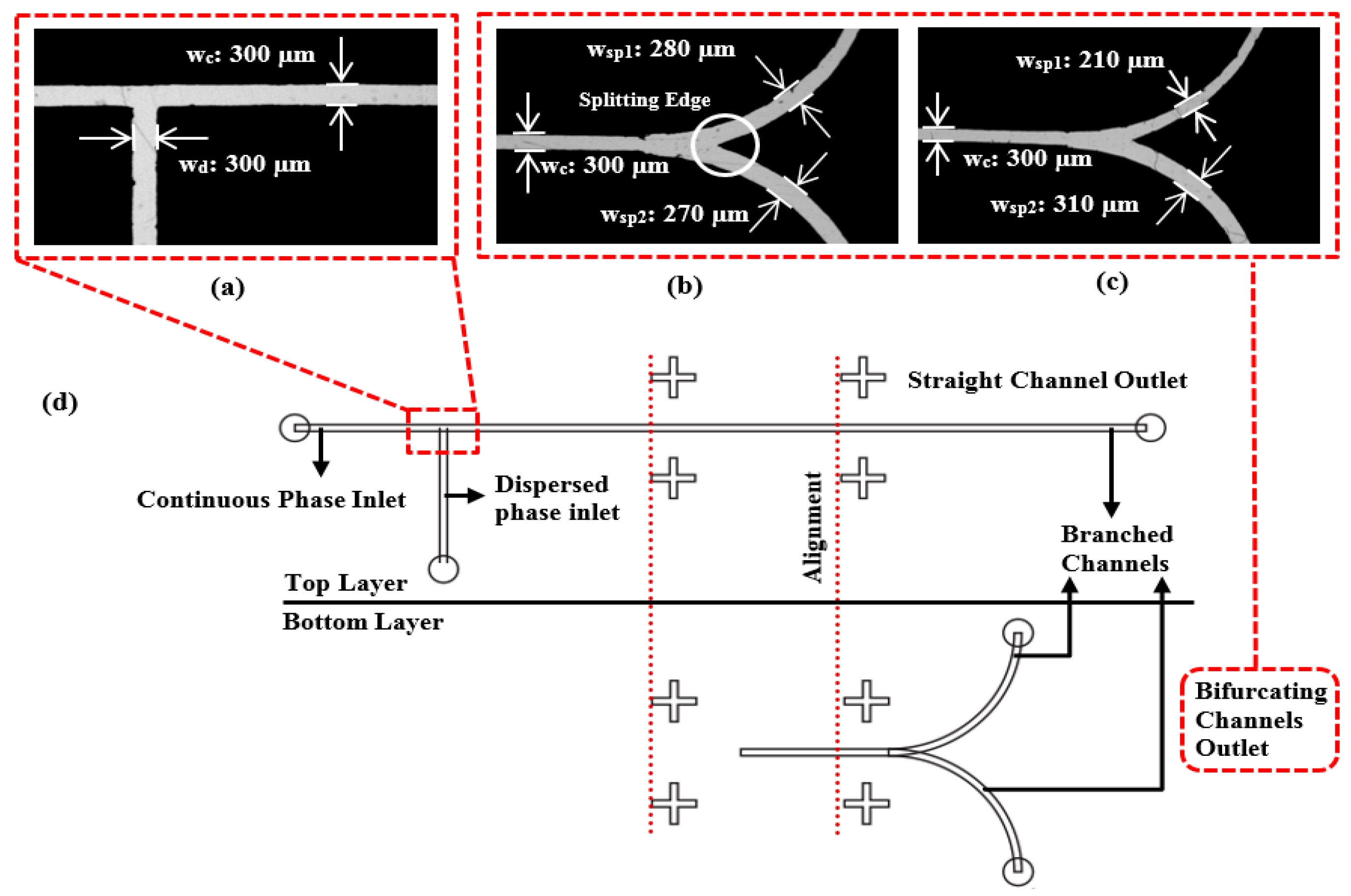

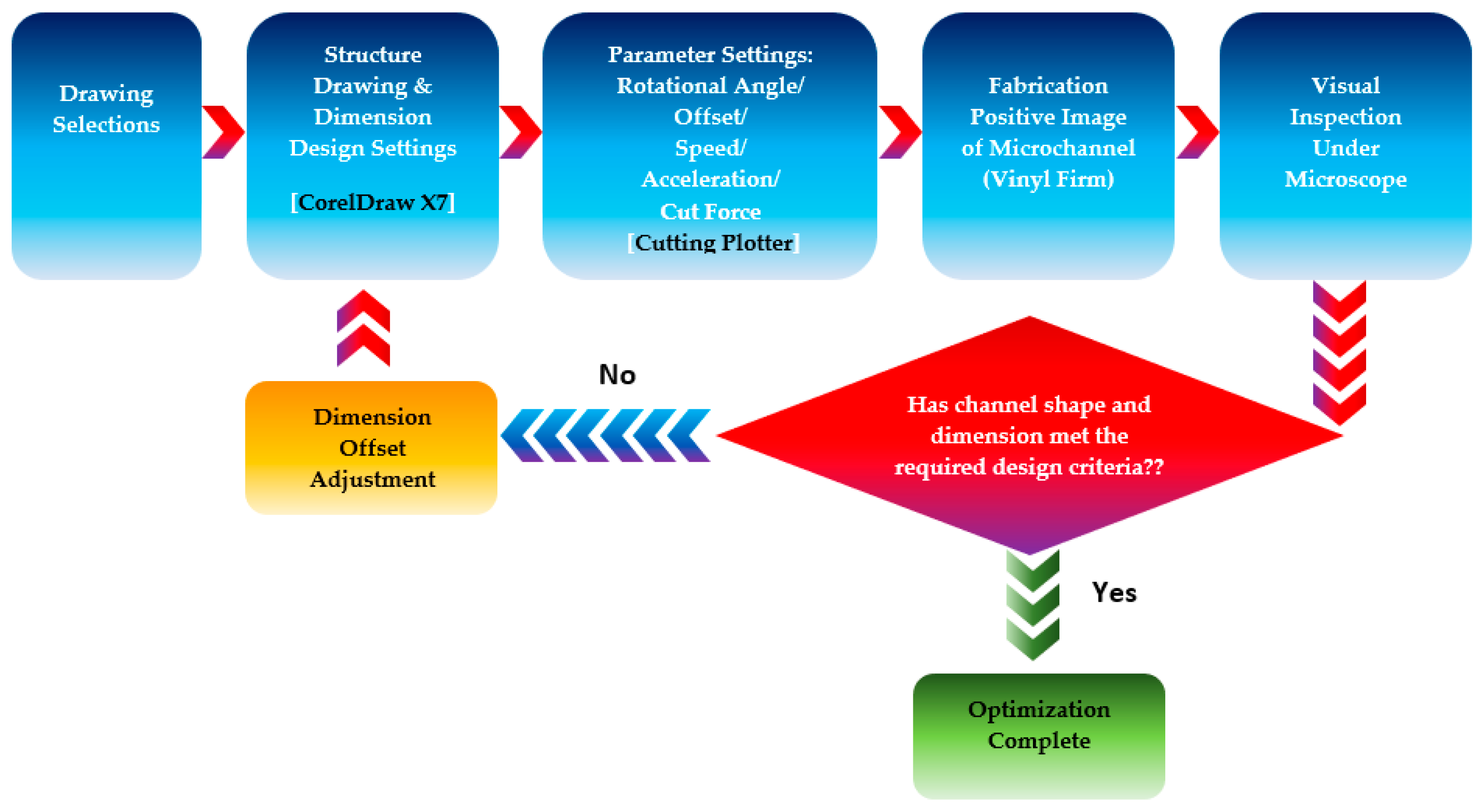
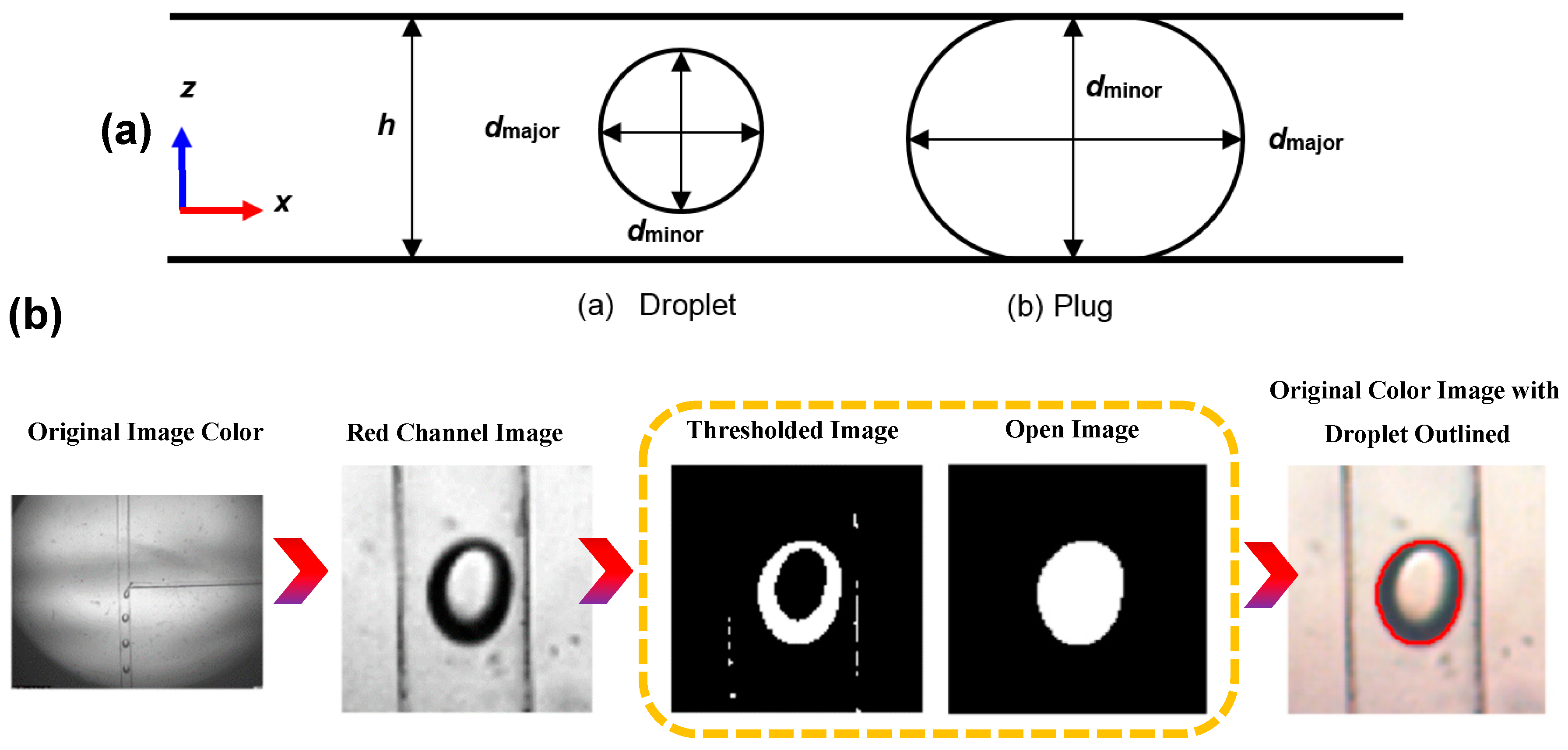


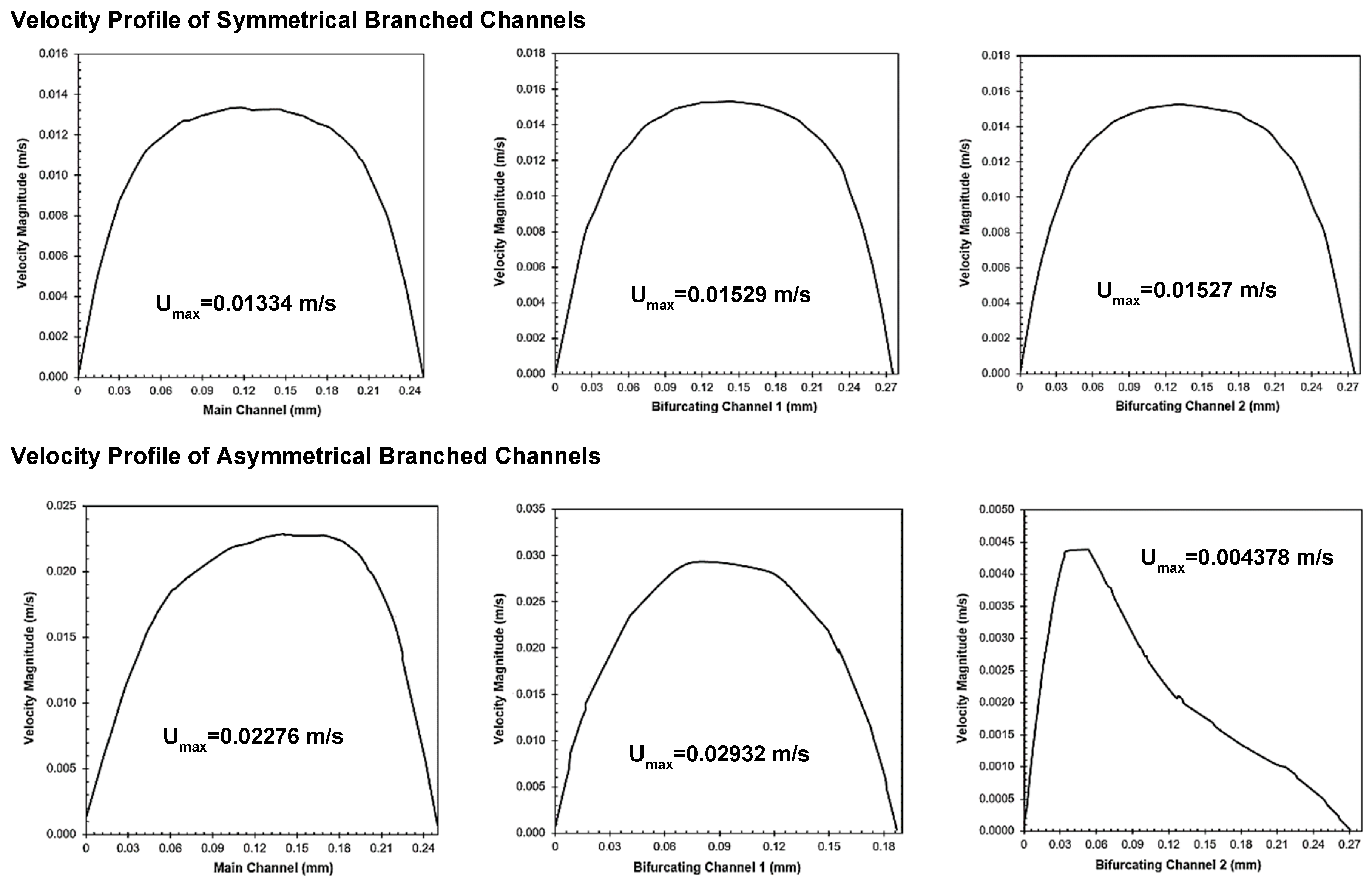
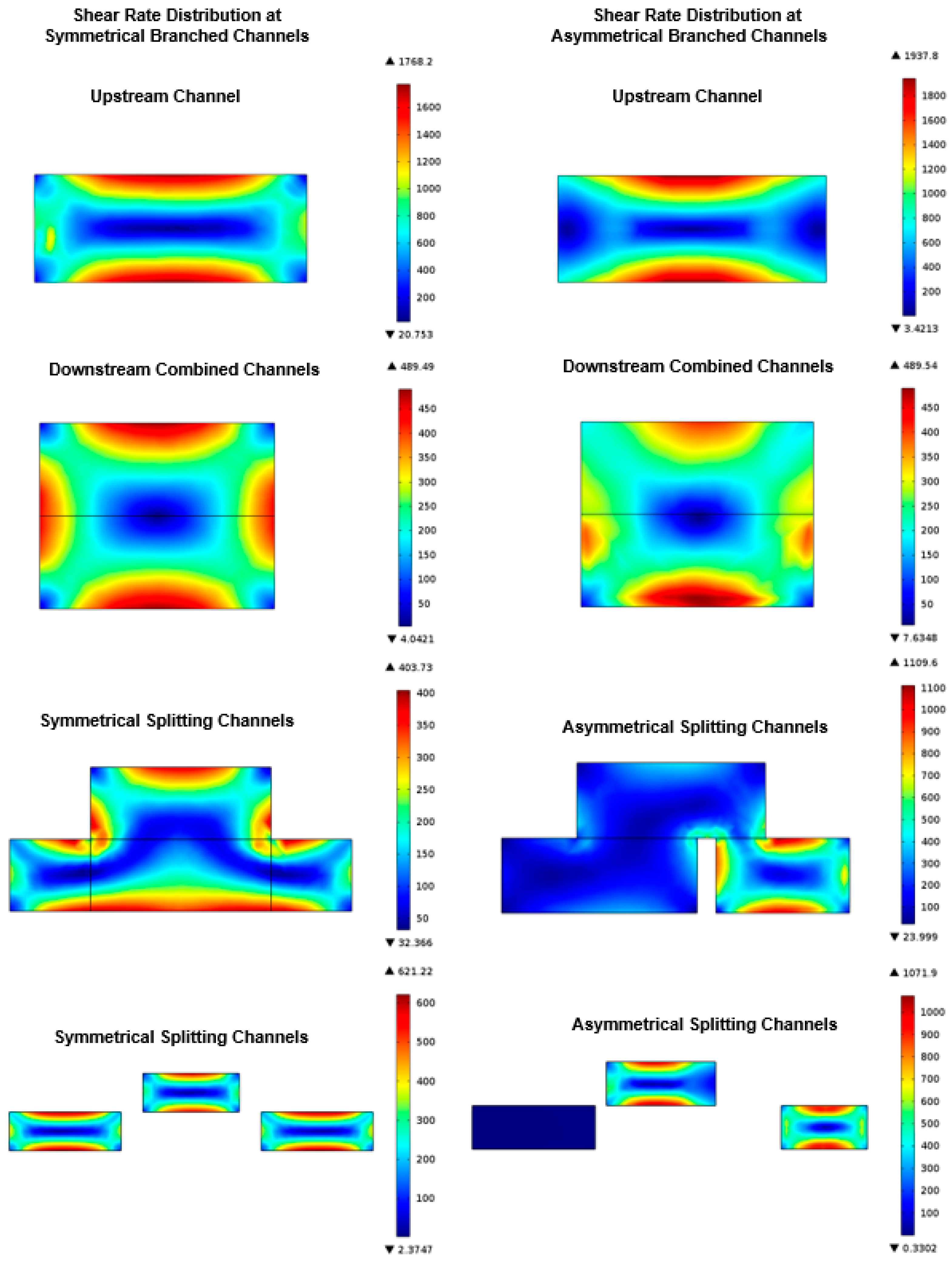
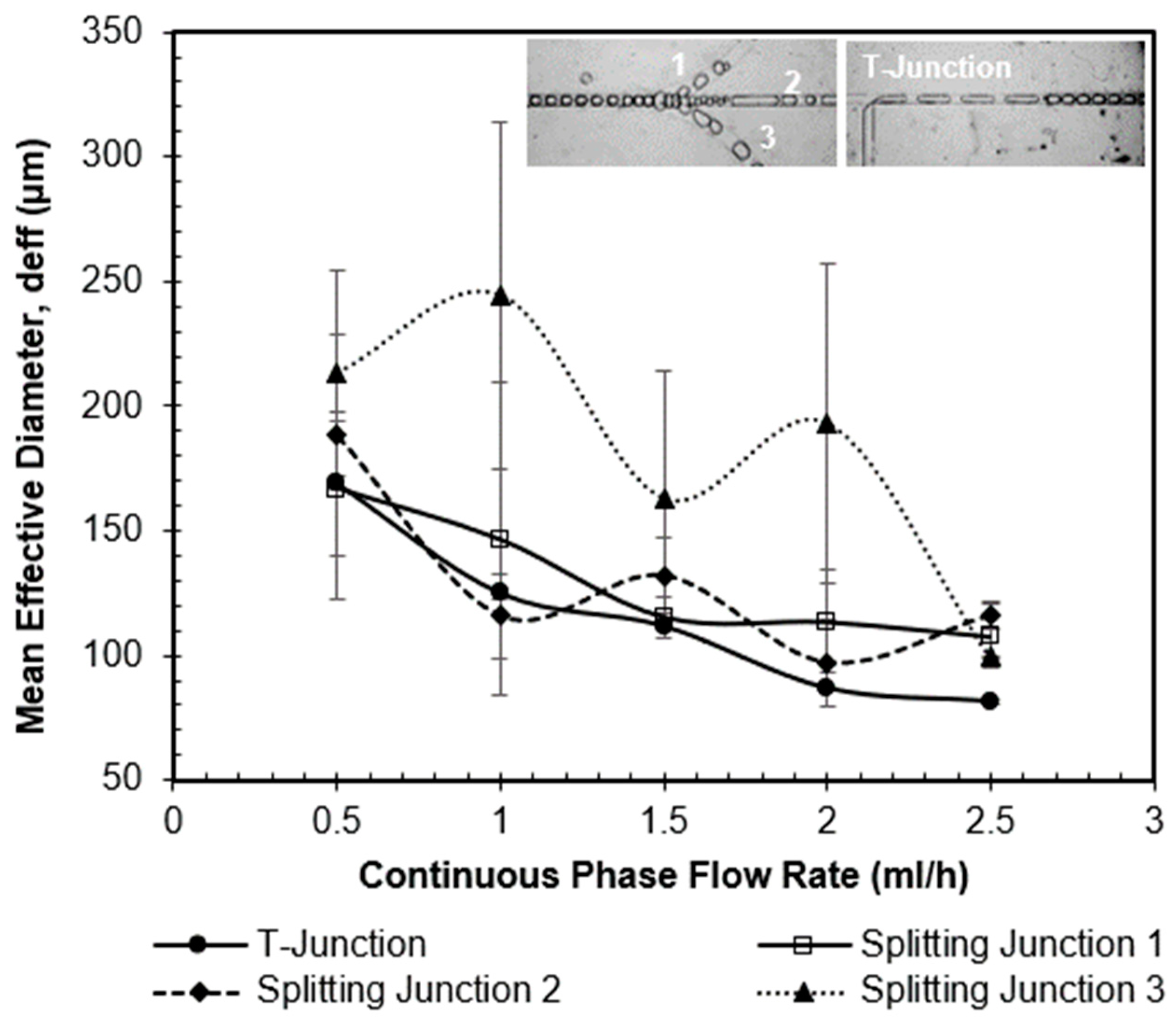
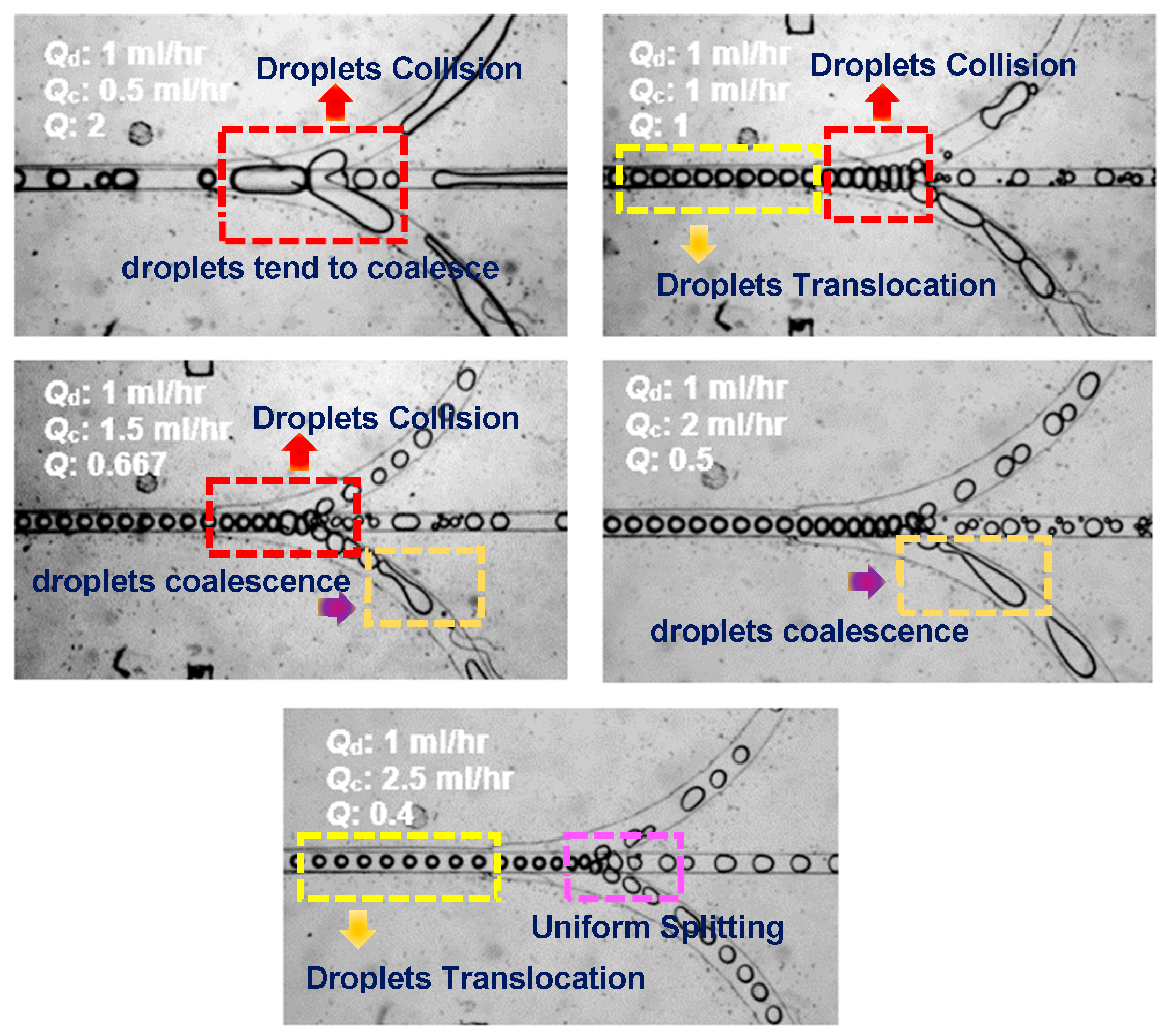




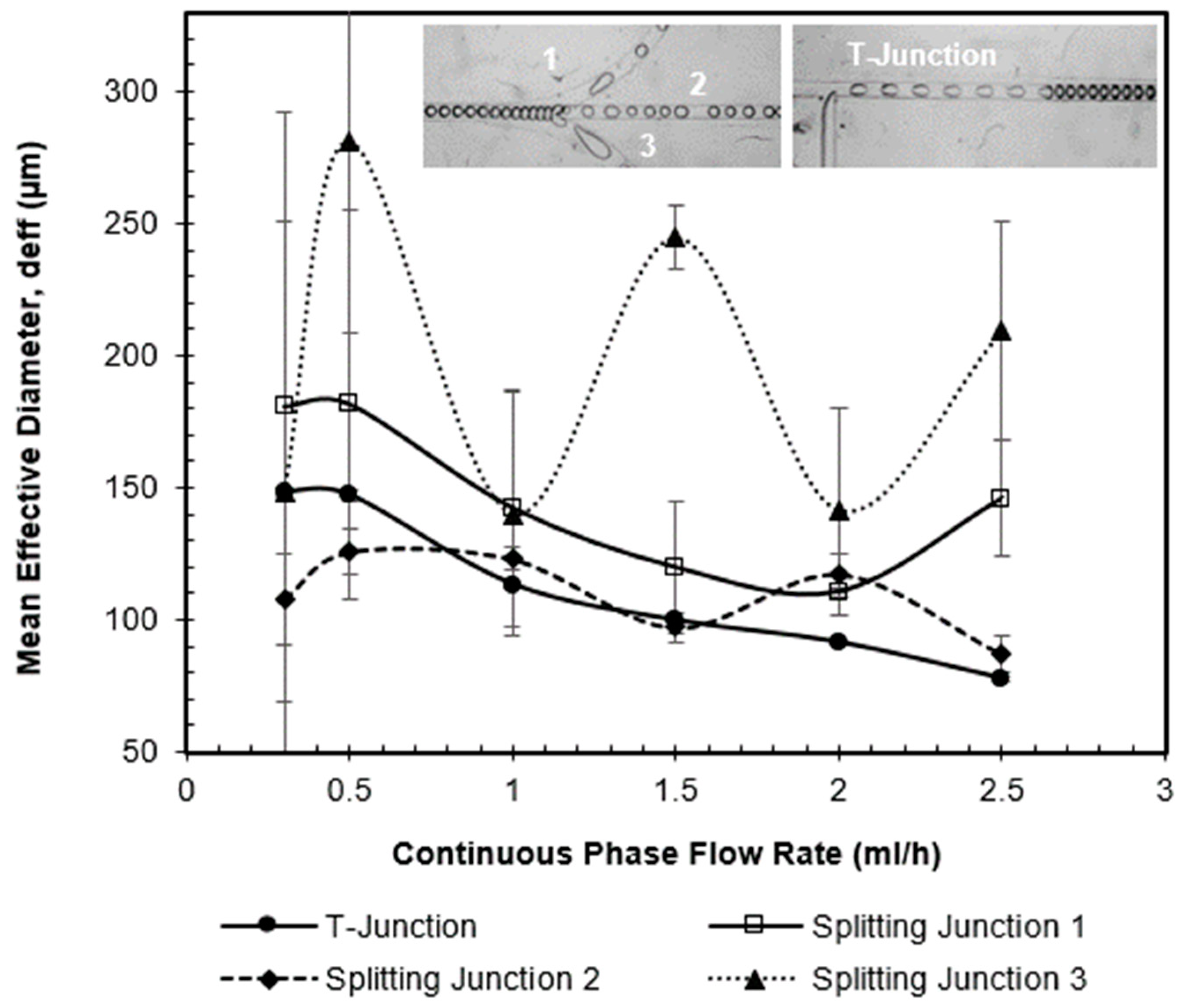

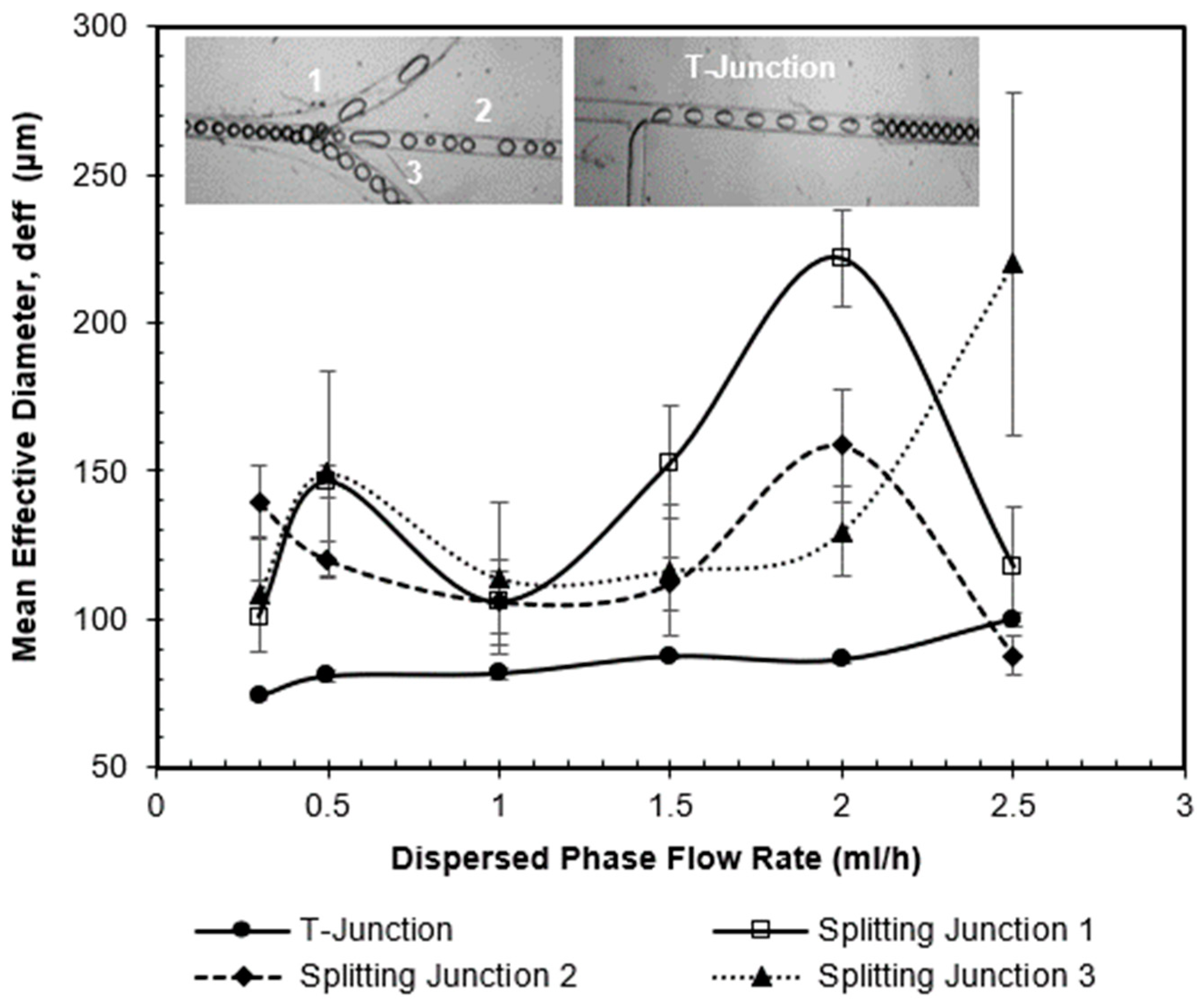

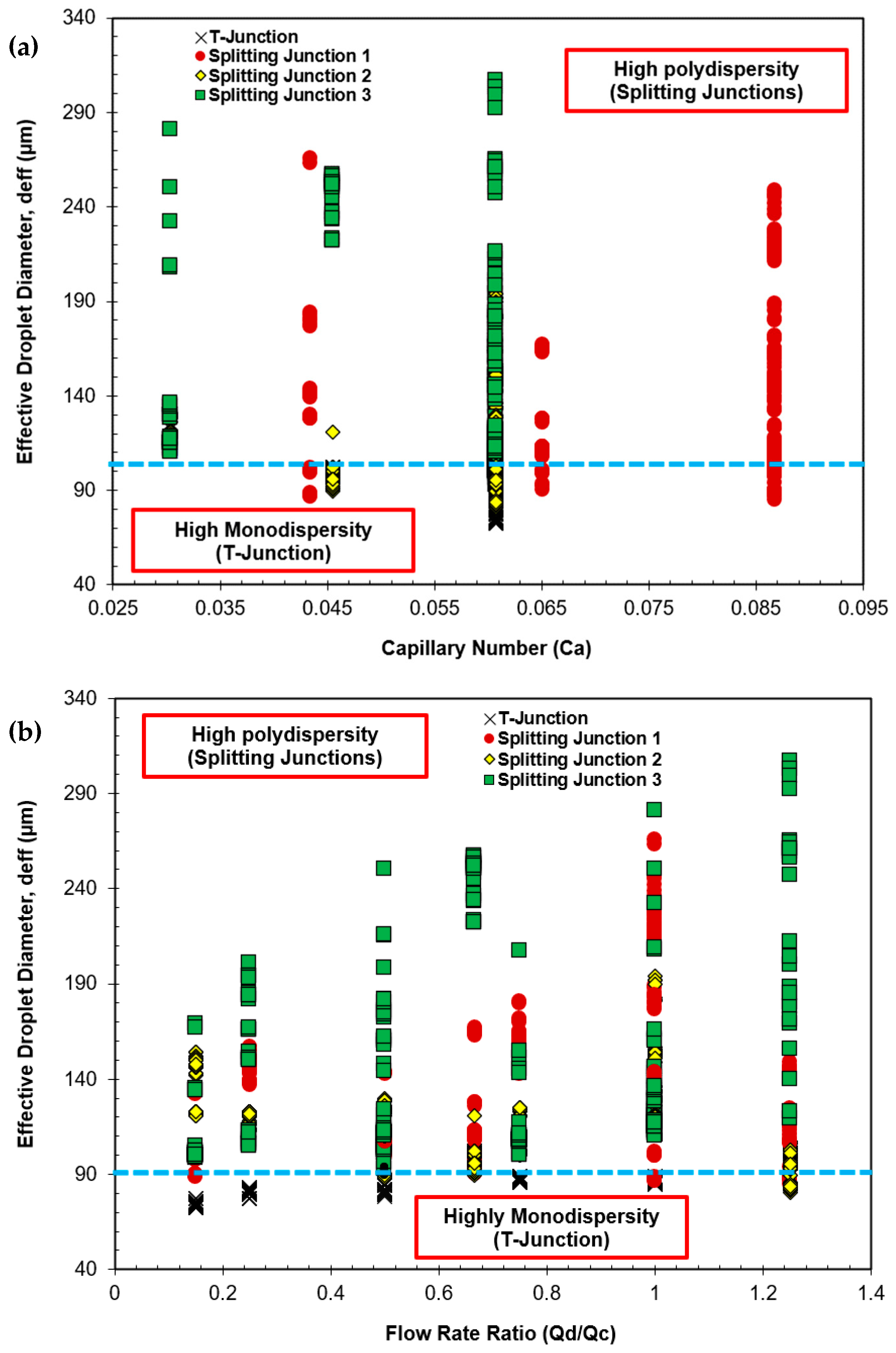
| Qc (mL/h) | Qd (mL/h) | T Junction (Upstream) | Splitting Junction 1 (Downstream) | Straight Junction 2 (Downstream) | Splitting Junction 3 (Downstream) |
|---|---|---|---|---|---|
| Coefficient of Variation (CV%) | |||||
| 2.00 | 0.30 | 3.14 | 14.61 * | 11.15 * | 3.96 |
| 2.00 | 0.50 | 0.73 | 17.87 * | 9.22 | 5.38 |
| 2.00 | 1.00 | 1.66 | 7.48 | 7.54 | 3.65 |
| 2.00 | 1.50 | 7.54 | 11.85 * | 16.10 * | 33.14 * |
| 2.00 | 2.00 | 17.27* | 54.45 * | 15.40 * | 32.38 * |
| 2.00 | 2.50 | 13.96* | 45.89 * | 27.73 * | 25.50 * |
| 0.50 | 1.00 | 1.56 | 16.10 * | 35.19 * | 7.16 |
| 1.00 | 1.00 | 2.02 | 42.72 * | 14.99 * | 28.46 * |
| 1.50 | 1.00 | 1.10 | 7.05 | 11.33 * | 31.62 * |
| 2.00 | 1.00 | 1.14 | 18.07 * | 17.55 * | 33.31 * |
| 2.50 | 1.00 | 1.20 | 11.76 * | 4.66 | 0.72 |
| Qc (mL/h) | Qd (mL/h) | T Junction (Upstream) | Splitting Junction 1 (Downstream) | Straight Junction 2 (Downstream) | Splitting Junction 3 (Downstream) |
|---|---|---|---|---|---|
| Coefficient of Variation (CV%) | |||||
| 2.00 | 0.30 | 1.76 | 11.87 * | 9.13 | 17.76 * |
| 2.00 | 0.50 | 2.13 | 3.47 | 4.94 | 23.30 * |
| 2.00 | 1.00 | 2.57 | 9.78 | 13.83 * | 22.48 * |
| 2.00 | 1.50 | 0.85 | 12.30 * | 7.75 | 19.21 * |
| 2.00 | 2.00 | 1.08 | 7.30 | 12.04 * | 11.63 * |
| 2.00 | 2.50 | 2.39 | 17.38 * | 7.32 | 26.19 * |
| 0.30 | 1.00 | 1.16 | 61.95 * | 16.22 * | 69.38 * |
| 0.50 | 1.00 | 1.39 | 40.44 * | 6.61 | 25.83 * |
| 1.00 | 1.00 | 0.99 | 31.64 * | 3.60 | 32.71 * |
| 1.50 | 1.00 | 1.50 | 20.71 * | 5.93 | 5.00 |
| 2.00 | 1.00 | 1.35 | 1.50 | 6.17 | 27.75 * |
| 2.50 | 1.00 | 1.18 | 14.86 * | 7.91 | 19.75 * |
© 2020 by the authors. Licensee MDPI, Basel, Switzerland. This article is an open access article distributed under the terms and conditions of the Creative Commons Attribution (CC BY) license (http://creativecommons.org/licenses/by/4.0/).
Share and Cite
Lu, I.-L.; Wong, V.-L.; Chin, J.-K.; Kushaari, K. Water Droplets Translocation and Fission in a 3D Bi-Planar Multifurcated T-Junction Microchannels. Processes 2020, 8, 510. https://doi.org/10.3390/pr8050510
Lu I-L, Wong V-L, Chin J-K, Kushaari K. Water Droplets Translocation and Fission in a 3D Bi-Planar Multifurcated T-Junction Microchannels. Processes. 2020; 8(5):510. https://doi.org/10.3390/pr8050510
Chicago/Turabian StyleLu, Inn-Leon, Voon-Loong Wong, Jit-Kai Chin, and Kuzilati Kushaari. 2020. "Water Droplets Translocation and Fission in a 3D Bi-Planar Multifurcated T-Junction Microchannels" Processes 8, no. 5: 510. https://doi.org/10.3390/pr8050510





